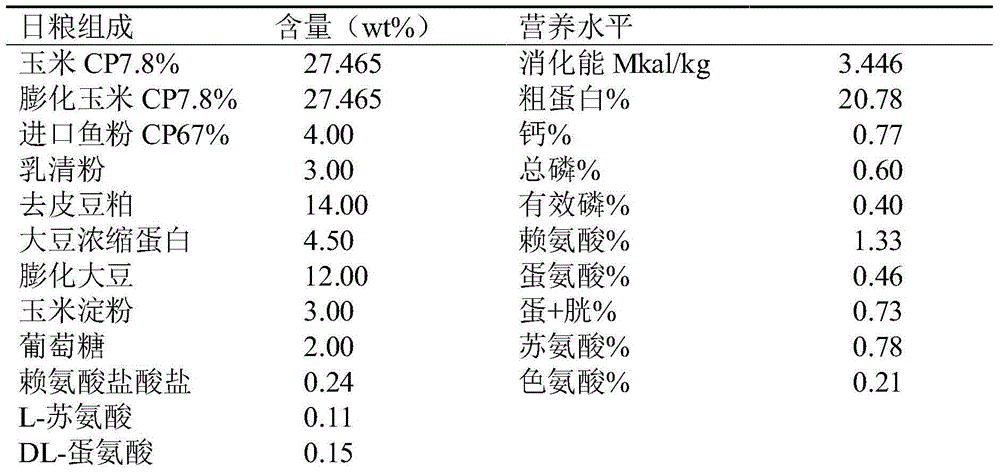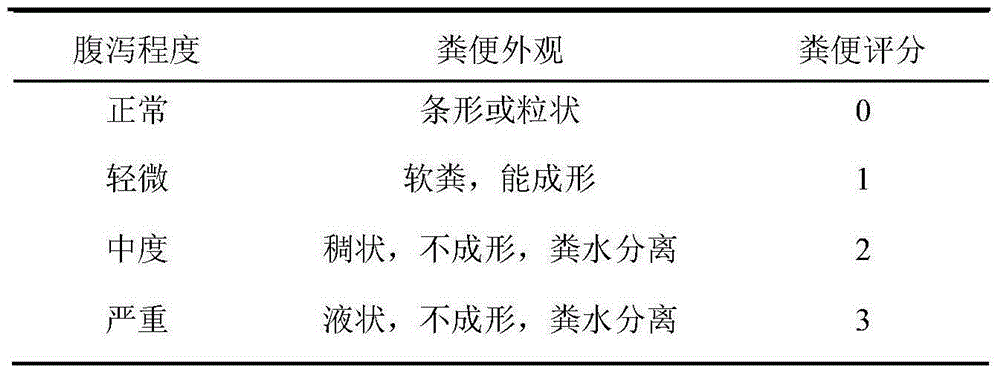Amino acid additive capable of improving growth capacity and intestinal health of weaned pig
An additive and amino acid technology, applied in animal feed, animal husbandry, application, etc., can solve problems such as changes in intestinal mucosal structure, impaired intestinal barrier function in piglets, and increased permeability of intestinal epithelial barrier, so as to improve intestinal Intestinal health, improving intestinal immune function, and promoting the improvement of animal intestinal structure
- Summary
- Abstract
- Description
- Claims
- Application Information
AI Technical Summary
Problems solved by technology
Method used
Image
Examples
Embodiment 1
[0043] 1 test material
[0044] The amino acid additive is composed of the following components in various mass percentages:
[0045] Threonine 20%; Leucine 25%; Arginine 25%; Isoleucine 20%; Glutamine 10%.
[0046] 2 Experimental Design and Animals
[0047] In this experiment, 20 28-day-old healthy “Du × Chang × Da” three-way hybrid piglets weaned were randomly divided into two groups according to the principle of similar body weight, namely the control group and the additive group:
[0048] Control group:
[0049] Feeding the basal diet shown in Table 1;
[0050] Additive group:
[0051] Feed the following diet: the cornstarch that accounts for 0.5% of the total weight of the diet in the basal diet shown in Table 1 is replaced by the diet obtained after the amino acid additive obtained in the embodiment;
[0052] Each group had 10 replicates, and each replicate had 1 piglet. The test period is 10 days.
[0053] 3 experimental diet
[0054] The basal diet is a corn-so...
Embodiment 2
[0095] 1 test material
[0096] The amino acid additive is composed of the following components in various mass percentages:
[0097] Threonine 10%; Leucine 30%; Arginine 30%; Isoleucine 10%; Glutamine 20%.
[0098] 2 Experimental Design and Animals
[0099] In this experiment, 32 healthy “Du × Chang × Da” three-way hybrid piglets weaned at the age of 28 were selected, and a 2 × 2 two-factor experimental design was adopted. According to the principle of similar body weight, they were randomly divided into 4 groups, each group 8 Repeated, 1 pig per replicate, the test period was 17 days.
[0100] Control group:
[0101] Feeding the basal diet shown in Table 1;
[0102] Additive group:
[0103] Feed the following diet: the cornstarch in the basal diet shown in Table 1, which accounts for 1.0% of the total weight of the diet, is replaced by the diet obtained after the amino acid additive obtained in the embodiment;
[0104] The four groups in the experimental design are: ① ...
Embodiment 3
[0123] 1 test material
[0124] The amino acid additive is composed of the following components in various mass percentages:
[0125] Threonine 15%; Leucine 30%; Arginine 30%; Isoleucine 15%; Glutamine 10%.
[0126] 2 Experimental Design and Animals
[0127] In this experiment, 509 28-day-old healthy “Du × Chang × Da” three-way hybrid piglets were selected and randomly divided into two groups according to the principle of similar body weight, namely the control group and the additive group:
[0128] Control group:
[0129] Feeding the basal diet shown in Table 1;
[0130] Additive group:
[0131] Feed the following diet: the cornstarch in the basal diet shown in Table 1, which accounts for 1.0% of the total weight of the diet, is replaced by the diet obtained after the amino acid additive obtained in the embodiment;
[0132]In the additive group, amino acid additives were used to replace the same amount of corn starch to constitute the experimental diet.
[0133] There w...
PUM
 Login to View More
Login to View More Abstract
Description
Claims
Application Information
 Login to View More
Login to View More - R&D
- Intellectual Property
- Life Sciences
- Materials
- Tech Scout
- Unparalleled Data Quality
- Higher Quality Content
- 60% Fewer Hallucinations
Browse by: Latest US Patents, China's latest patents, Technical Efficacy Thesaurus, Application Domain, Technology Topic, Popular Technical Reports.
© 2025 PatSnap. All rights reserved.Legal|Privacy policy|Modern Slavery Act Transparency Statement|Sitemap|About US| Contact US: help@patsnap.com



